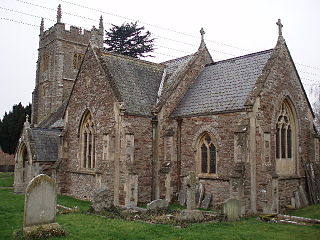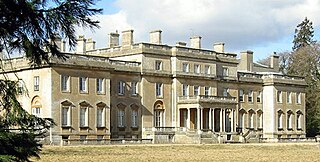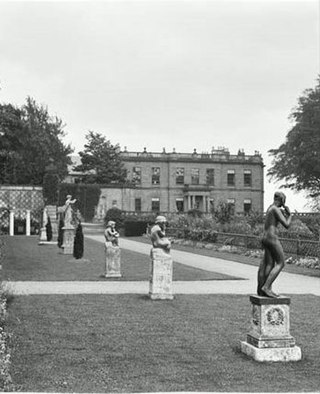
Earl of Portsmouth is a title in the Peerage of Great Britain. It was created in 1743 for John Wallop, 1st Viscount Lymington, who had previously represented Hampshire in the House of Commons. He had already been created Baron Wallop, of Farleigh Wallop in Hampshire in the County of Southampton, and Viscount Lymington, in 1720, also in the Peerage of Great Britain.
Mount Merrion is a suburb of Dublin, Ireland. It is roughly 7 kilometres (5 mi) south of Dublin city centre and is situated on and around the hill of the same name.

Durston is a village and civil parish in Somerset, England, situated on the A361 road 5 miles (8.0 km) north east of Taunton and 6 miles (9.7 km) south of Bridgwater in the Somerset West and Taunton district. The parish lies on undulating ground between the lowest slopes of the Quantock Hills and the valley of the River Tone at the Curry and Hay Moors. The parish has a population of 136.

Gunnersbury Park is a park in the London Borough of Hounslow between Acton, Brentford, Chiswick and Ealing, West London, England. Purchased for the nation from the Rothschild family, it was opened to the public by Neville Chamberlain, then Minister of Health, on 21 May 1926. The park is currently jointly managed by Hounslow and Ealing borough councils. A major restoration project funded by the Heritage Lottery Fund was completed in 2018. The park and garden is Grade II listed.

Mount Edgcumbe House is a stately home in south-east Cornwall and is a Grade II listed building, whilst its gardens and parkland are listed as Grade I in the Register of Parks and Gardens of Special Historic Interest in England.

Nuneham Courtenay is a village and civil parish about 5 miles (8 km) southeast of Oxford. It occupies a pronounced section of the left bank of the River Thames.

Pishiobury, sometimes spelled Pishobury, was a manor and estate in medieval Sawbridgeworth, Hertfordshire. Its denomination as "Pishiobury" only emerged in the mid to late 19th century.

The Swinton Estate is a large privately owned estate in North Yorkshire, England. It comprises some 20,000 acres (8,100 ha) of countryside in the Nidderdale Area of Outstanding Natural Beauty, extending 10 miles (16 km) west from the River Ure near Masham. The estate includes Swinton Park, the seat of the Danby family and of the Cunliffe-Lister family, an English country house in Swinton near Masham. It is set in 200 acres (81 ha) of parkland, lakes and gardens. The house is a Grade II* listed building, and now operates as the 42-bedroom Swinton Park Hotel.

Lathom House was a large country house in the parish of Lathom in Lancashire, England. Built between 1725 and 1740, the main block was demolished in 1925.

Tottenham House is a large Grade I listed English country house in the parish of Great Bedwyn, Wiltshire, about five miles southeast of the town of Marlborough. It is separated from the town by Savernake Forest, which is part of the Tottenham Park estate.

Newton Wallop, 6th Earl of Portsmouth JP, DL, styled Viscount Lymington until 1891, was a British Liberal politician but then joined the Liberal Unionist Party in 1886. He later switched back to the Liberal Party to serve as Under-Secretary of State for War under Sir Henry Campbell-Bannerman from 1905 to 1908.
John Conduitt, of Cranbury Park, Hampshire, was a British landowner and Whig politician. He sat in the House of Commons from 1721 to 1737. He was married to the half-niece of Sir Isaac Newton, whom Conduitt succeeded as Master of the Mint.

Marchmont House lies on the east side of the village of Greenlaw, and near to a church in Polwarth in Berwickshire, in the Scottish Borders area of Scotland. It is about five miles south west of Duns, about 19 miles (31 km) west of Berwick-upon-Tweed and about 40 miles (64 km) south east of Edinburgh. Situated in a gently undulating landscape, the estate is intersected by Blackadder Water, and its tributary burns. With the Lammermuir Hills to the north and views towards the Cheviot Hills in the south, this part of Berwickshire, sometimes referred to as the Merse, is scenic and contains rich agricultural land.

Windlestone Hall is a mid-16th century Elizabethan country house, heavily rebuilt in 1821 to form a Greek revival stately home, situated near Rushyford, County Durham, England. The Hall sits within 400 acres of designed parkland. It is a Grade II* Listed building. As of 2022 it is back in private family ownership, with the surrounding estate maintained and conserved by a dedicated heritage charitable trust.

Milton Hall near Peterborough, is the largest private house in Cambridgeshire, England. As part of the Soke of Peterborough, it was formerly part of Northamptonshire. It dates from 1594, being the historical home of the Fitzwilliam family, and is situated in an extensive park in which some original oak trees from an earlier Tudor deer park survive. The house is a Grade I listed building; the garden is Grade II*.
John Wallop, 1st Earl of Portsmouth, of Hurstbourne Park, near Whitchurch and Farleigh Wallop, Hampshire, known as John Wallop, 1st Viscount Lymington from 1720 to 1743, was a British politician who sat in the House of Commons from 1715 to 1720, when he vacated his seat on being raised to the peerage as Viscount Lymington and Baron Wallop.

John Wallop, 2nd Earl of Portsmouth, styled Hon. John Wallop from 1743 to 1749 and Viscount Lymington from 1749 to 1762, was a British nobleman.

The feudal barony of Bampton was one of eight feudal baronies in Devonshire which existed during the mediaeval era, and had its caput at Bampton Castle within the manor of Bampton.
Leonie Kira Emma Schroder is a British billionaire heiress, and the daughter of the late Bruno Schroder of the Schroders dynasty. After his death in March 2019, she took over his seat on the board of directors.

Isaac Newton Wallop, 5th Earl of Portsmouth DL JP(11 January 1825 – 4 October 1891) was a British Peer and the son of Newton Fellowes, 4th Earl of Portsmouth and Lady Catharine Fortescue.
















